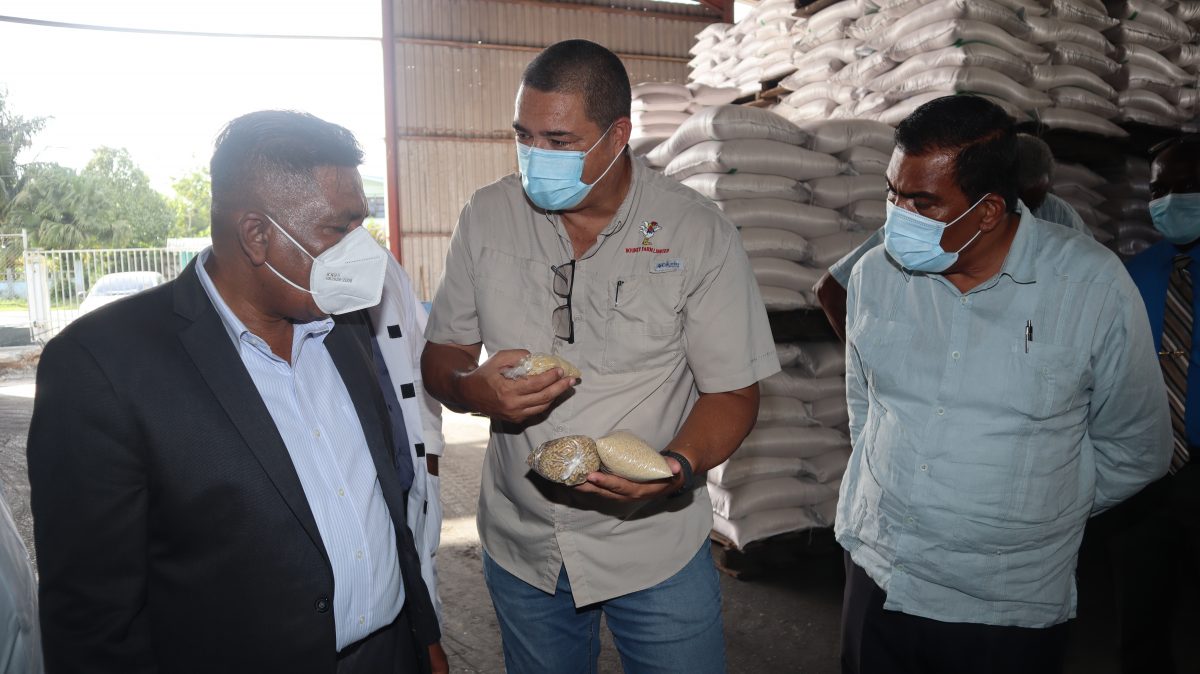Local investors are to undertake an agricultural project intended to eliminate the dependence of the poultry sector on imported feed supplies.
A Ministry of Agriculture release yesterday announced that six local companies have joined forces to undertake a “massive project” that could place Guyana on the path to becoming self-sufficient in corn and soya bean over the next few years.
The consortium which consists of Guyana Stockfeeds Ltd, Royal Chicken, Edun Farms, SBM Wood, Dubulay Ranch and Bounty Farm Ltd, along with the Brazilian-owned N F Agriculture plans to produce soya bean and corn for both the local and the regional markets. So far, the team has engaged several other relevant bodies like the Guyana Lands and Surveys Commission (GLSC), the Guyana Office for Investment (G-Invest), and other relevant stakeholders. Once given the green light, cultivation is expected to commence before the end of the year.
Assistant Managing Director of Bounty Farm Limited, David Fernandes, in explaining the group’s vision for the project, noted that in recent years the poultry sector has been paying attention to the high dependence on imports for livestock feeds.
“With the onset of Covid-19, we have realized our vulnerability to global prices, supply, and freight variability. This underscored the importance of self-reliance in the area of food security. As a group, we want to be able to help transform Guyana’s food and agricultural systems, shorten the value chains nationally and regionally, become self-sufficient in commodities needed for the poultry industry, create employment, and boost rural development among other things,” Fernandes said.
He added that such a massive project would significantly reduce the cost of raw materials for livestock production while improving Guyana’s competitive advantage in the global marketplace.
According to the release, Guyana currently spends close to US$25 million annually on proteins for the poultry sector. And in an effort to rein in this expenditure, government, since taking office, has taken steps to promote domestic cultivation of corn and soya bean. Also, in its 2020 Emergency Budget, government, removed value-added tax (VAT) on agriculture machinery, fertilisers, agrochemicals, and pesticides, making it more feasible for such investments. Additionally, land lease fees across all sectors have been reduced and water charges have been reset to 2014 rates. This year’s budget also saw an allocation of an additional $500 million to develop the corn and soya bean industry. This is to ensure that the necessary infrastructure is in place to support private investment. Investors from Dubai, United Arab Emirates have also signalled their interest in cultivating corn and soya bean locally.
Agriculture Minister Zulfikar Mustapha said in the release that government is keen on reducing spending, especially on commodities that can be produced locally. He assured that government is ready to work with investors and provide the necessary support to ensure projects of this nature get off the ground.
“We already have an investor from Brazil who is doing corn cultivation in the Ebini, located in upper Berbice River and I am looking forward to seeing more companies coming on board. Today’s presentation was well received and I commend our local investors for signalling their interest in such a large-scale project. If we can produce the amount of corn and soya bean required to become self-sufficient in proteins for our poultry industry, those funds can be used to further develop the sector. As a government, we are also working to reduce Guyana’s food import bill and food import dependency,” Mustapha was quoted as saying.
He also said that government will be making the necessary resources available to enable the project to commence as soon as possible. It also plans to explore having a public/private partnership with an initial investment of $500 million being allocated to begin infrastructural works in areas like the Intermediate Savannahs that have been earmarked for the cultivation of corn and soya bean, and other large-scale agriculture activities like the development of mega-farms.
Presently, Guyana’s national feed consumption for the poultry industry is 113,000 metric tons annually. Broiler birds consume approximately 100,000 metric tons of feed and layers, approximately 13,000 metric tons of feed annually. This feed comprises 60% grain (corn & rice), which is equivalent to approximately 68,000 tons, and 30% soya bean meal which is equivalent to approximately 34,000 tons per year, the release added.






